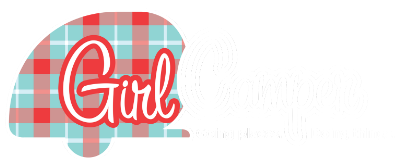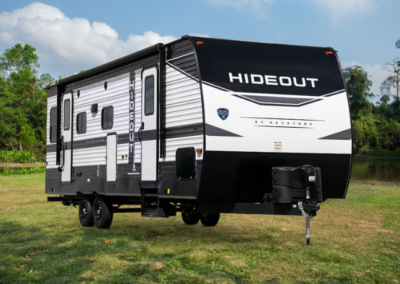By Lisa Dempsey
Gray Water Tank Conservation at the Campsite
When I have the choice between full hook-ups with sewer access or just electric and water, I choose full hook-ups for my trailering adventures so I don’t have to worry about gray water tank conservation. Go ahead and call me a bougie Girl Camper. I love the comforts traveling with my home on wheels provides, including a hot shower after a day outdoors. But I also adore the beauty of being in a more natural camping area that may not have sewer hook-ups at the campsite. The best way to avoid having to move your trailer to a dump station during the middle of your stay is to conserve water usage that will fill up your camper’s gray water tank.
NOTE: This isn’t an article about boondocking or dry camping, where you would also need to conserve your overall water usage. I’m assuming you have access to water hook-ups at your campsite.
Here are a few tips I’ve learned along the way. Please share yours in the comments to help other Girl Campers learn how to avoid filling up the gray water tank between visits to the dump station.
Let’s Talk About Showering
- If the campground has a bathhouse, consider using it for your showers. Click here for one of my secrets for showering at the campground.
- Set up an outside shower. Many trailers come with an outdoor shower. You can set up a pop-up dressing tent or other similar setup.
- Check out the Shower Toga if you feel a little modest showering outside your trailer.
- Inside your trailer, consider installing a low-flow showerhead in your camper’s bathroom. These devices use less water per minute without compromising your shower experience. You’ll save gallons of water during each shower. Check out Camco’s shower head with the convenient on/off switch.
- Take shorter showers and use a combination of body cleansing wipes or the old-fashioned “sink bath” with a washcloth and bucket of warm water. A “bathing towelette” is an excellent thing to keep in the trailer. Check out the Dead Down Wind brand – unscented, so you don’t attract bears and bugs. This towelette is perfect to have on hand for sportswomen and hikers, too.


Let’s Talk About Dirty Dishes
- Some campgrounds will have a sink area set up for washing dishes. Make sure to take your own dish towels and drying racks. Having mesh bags for dishwashing in communal sinks is very helpful. These are often called “dunk bags” or “mess kit” mesh bags.
- Have a couple of large buckets or wash bins, one for washing and one for rinsing. It is optimal if you can set them up outside. This is one of those times when having a Y-splitter on your campground water spigot is handy. I have an outdoor shower on my trailer, and I set up a table next to it to use, so I have the bonus of having hot water to wash my dishes. Always wipe your dishes off, removing as much debris as possible into the trash receptacle before putting the dishes in the water to wash.
- Be sure to keep this food debris and trash away from the wildlife in the area and dispose of it properly. You can sanitize your dishes by rinsing them in at least a gallon of water with a tablespoon of bleach, then let them air dry. You can follow the CDC guidelines here.
- Use a metal mesh kitchen strainer to capture any other food debris when disposing of the water. I like to use this water to put out the campfire at night. Follow the campground rules for disposing of the water. You can typically dispose of the strained grey water if you have used biodegradable camp soap and are more than 200 feet from a body of water. Again, follow the campground rules for disposal.
- Yes. You can use paper plates and cups to avoid doing the dishes completely. Please avoid Styrofoam cups. They do not degrade and can be harmful to wildlife.



Quick Rinse Set Up
I use my “dishwashing station” set up on a table next to my outdoor shower as a quick rinse station during the day. My hands get sticky and dirty, and I find that I wash my hands often when I’m camping. It is incredible how much water I can use during the day. I have two buckets, one for washing my hands and the other for rinsing. Then, I follow up with some hand sanitizer. I could use wet wipes, but I don’t feel like they get the grime off my hands.
Let’s Talk About Soap
There are camping-specific soap brands that offer eco-friendly and versatile solutions to keep you and your camping gear clean while minimizing your environmental impact. Look for biodegradable on the label. Depending on where you are camping, you may opt for unscented products to avoid attracting wildlife and insects to you and your campsite.
Sierra Dawn’s Campsuds has been around since 1968 and can be found in most camping aisles in your local Walmart.
Sea to Summit has a wide range of products. You can order off the website or find them in your local REI.
Dr. Bronner’s brand is also popular among outdoor enthusiasts. It is a versatile product and can be used on your face, body, and hands, as well as for cleaning up your dishes. They provide a cheat sheet on how to dilute the soaps for different uses. Click here to get a copy of the Dr. Bronner Dilutions Cheat Sheet.
Check the manufacturer’s websites or local retailers for the specific camping soap products that suit your needs.

Monitor Your Water Use
There are dozens of ways to conserve water and keep your gray water tanks from filling up too quickly on a campout. These are just a few tips for the primary water uses, but every bit adds up. Monitor your water usage. Keep a close eye on your gray water tank’s level indicator, or manually check it regularly. This way, you can gauge your water usage daily and avoid overfilling the tank before you are ready to unhook and head to the nearest dump station.


Lisa Dempsey is the Southeast Texas Chapter Guide for Girl Camper. She lives in Kingwood, Texas, with her husband Robert, two fluffy Cardigan Welsh Corgis, and her teenage son. In addition to being a guide, Lisa is the CEO and Founder of the Forgotten Wishes Foundation, whose mission is to help people with disabilities combat feelings of loneliness and isolation and create a society of belonging.
Girl Camper is a women’s lifestyle brand focusing on camping, outdoor activities, camaraderie, and travel. Our national company produces the award-winning Girl Camper Magazine, has a website with informative and fun blog posts, hosts events and excursions, and maintains national and local social network communities on Facebook. Search for Girl Camper on Facebook and find your local chapter.




